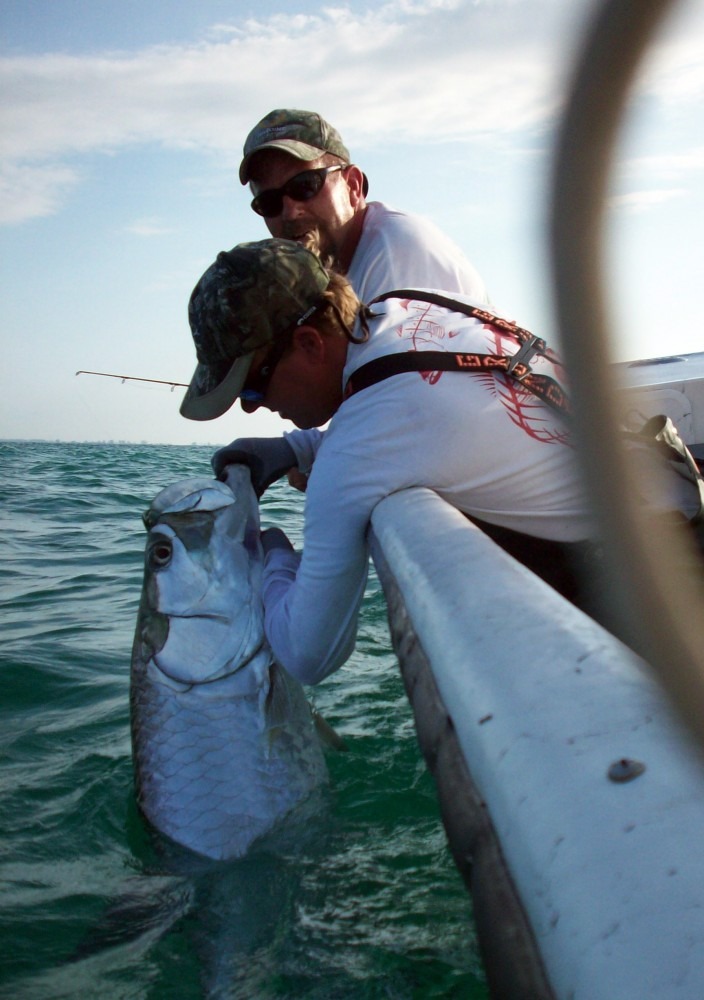Return of the once and future king – Tarpon return to AMI waters
It is happening again.
The Royal Poinciana trees are in bloom, boasting an enormous fiery crown of orange flowers casting shade over well-manicured lines.
The love bugs are flying in pairs joined together at the abdomen performing their aerial mating ritual.
The winds have subsided, allowing large cumulonimbus clouds to form in the east growing as they gracefully float toward the coast.
It’s hot.
Warm, balmy air in the form of light breezes emanates from the south.
Water and air temperatures are the same.
Gentle waters that ripple on sandy white beaches wash coquinas out of the sand forcing them to quickly nuzzle themselves back underground.
The full moon in June is slowly approaching, as strong outgoing tides flush pass crabs out around Bean Point and into the Gulf.
And the fever is settling in. Sleepless nights, long hot days spent on the boat patrolling the shorelines for a flash. Or a roll. Or even a free-jumping fish. Sunburn and dehydration become common place for the weeks to come. The constant preoccupation of getting hooked up consumes you. There is utter disregard for just about everything else — except eating and sleeping.
That’s right.
It’s tarpon season on Anna Maria Island. Anglers from all over the world are arriving with hopes of hooking into the infamous silver king. These tackle-busting oversized shiners capture the hearts and souls of seasoned and rookie anglers. And once you have the fever there’s only one remedy — you fish until one of these shiny metallic giants eat your bait.
And then there’s the rush.
There it is.
That initial shock the first time the fish breaks the surface of the water is unforgettable. An acrobatic display of pure power ending in an eruption of splashing and the sound of the drag as your line strips off the reel at alarming speeds.
And don’t forget when the majestic fish jumps you must “bow to the king.” As a fish is airborne you extend your rod forward causing you to bow. This puts a slight slackness in the line to absorb the spastic head shaking of the fish. Failure to do so can result in getting broken off. A sound resembling a shot from a 22 rifle emits through the air is the line breaks and the rod goes straight again. And then it’s over.
But, if you’re lucky enough to stay hooked up after the fish lands then the fight ensues. Runs of 100-yards or more occur during the early stages of the battle as the large fish swishes their big tail in desperation to get away.
It’s been 15 minutes now.
You’ve managed to get back 3/4 of your line back on the reel. The fish is close. It’s now slowing down. Swimming circles deep under the boat. Finally, you see a flash 10 feet down in the emerald green water. One more pump of the rod and a quick reel and the leader is showing. The fish slowly surfaces and rolls on its side.
Holding the leader in one hand you reach into its mouth with the other. You grab onto that bony lower jaw tightly and hold the fish steady. A quick twist of the pliers and the large circle hook becomes unbuttoned from the over-sized jaw.
As you hold the fish you make eye contact. As that big eye stares back at you, it’s as if the fish is examining you, as much as you are it. It is a profound moment. There’s definitely something going on behind that eye.
At this point, it’s time to make sure the fish is revived enough to release. Slowly moving the boat forward and holding the fish aids in flushing water through its gills.
A few moments more, the fish shakes its head, and it’s ready to be released.
Drenched in sweat with arms shaking do due to fatigue, you watch the fish slowly swim back to the depths.
A memory has been made. You matched wits and strength with the silver king and you came out on top.

